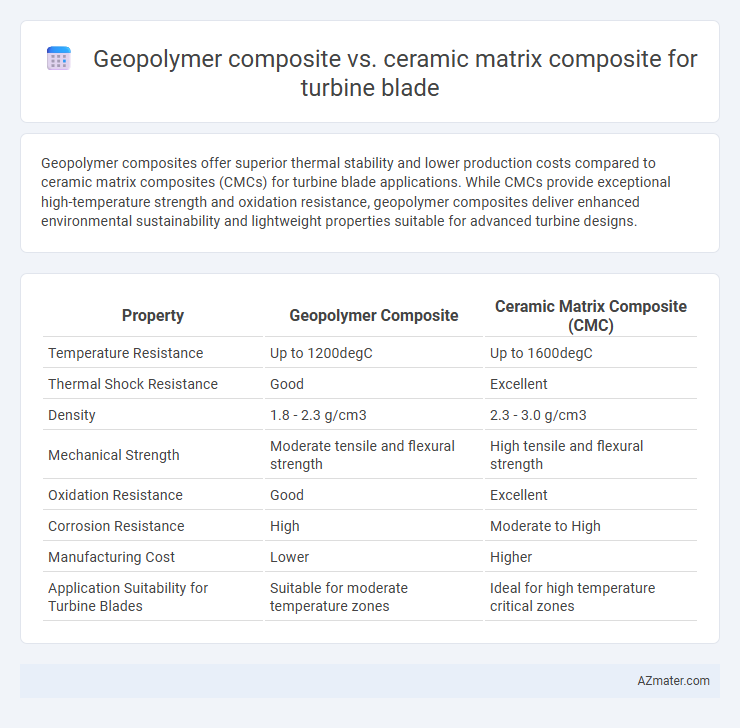Geopolymer composites offer superior thermal stability and lower production costs compared to ceramic matrix composites (CMCs) for turbine blade applications. While CMCs provide exceptional high-temperature strength and oxidation resistance, geopolymer composites deliver enhanced environmental sustainability and lightweight properties suitable for advanced turbine designs.
Table of Comparison
| Property | Geopolymer Composite | Ceramic Matrix Composite (CMC) |
|---|---|---|
| Temperature Resistance | Up to 1200degC | Up to 1600degC |
| Thermal Shock Resistance | Good | Excellent |
| Density | 1.8 - 2.3 g/cm3 | 2.3 - 3.0 g/cm3 |
| Mechanical Strength | Moderate tensile and flexural strength | High tensile and flexural strength |
| Oxidation Resistance | Good | Excellent |
| Corrosion Resistance | High | Moderate to High |
| Manufacturing Cost | Lower | Higher |
| Application Suitability for Turbine Blades | Suitable for moderate temperature zones | Ideal for high temperature critical zones |
Introduction to Advanced Turbine Blade Materials
Geopolymer composites offer enhanced thermal stability and lower density compared to traditional materials, making them promising candidates for turbine blade applications where weight reduction is critical. Ceramic matrix composites (CMCs) provide superior high-temperature strength and resistance to oxidation, essential for blades operating in extreme environments. Advancements in these materials aim to improve turbine efficiency, durability, and performance under thermal and mechanical stresses.
Understanding Geopolymer Composites
Geopolymer composites consist of an inorganic polymer binder derived from aluminosilicate materials, offering superior thermal stability and resistance to high temperatures compared to traditional polymers. These composites exhibit enhanced mechanical properties, including high compressive strength and excellent corrosion resistance, making them suitable for use in turbine blades exposed to extreme environments. Understanding the microstructure and curing process of geopolymer composites is essential for optimizing their performance in turbine blade applications, providing a cost-effective and environmentally friendly alternative to ceramic matrix composites.
Overview of Ceramic Matrix Composites
Ceramic Matrix Composites (CMCs) consist of ceramic fibers embedded within a ceramic matrix, offering exceptional high-temperature resistance and mechanical strength crucial for turbine blades. These composites exhibit superior thermal stability, oxidation resistance, and fracture toughness compared to traditional materials, enabling improved engine efficiency and durability. CMCs are widely used in advanced aerospace turbines due to their ability to withstand temperatures exceeding 1,200degC while maintaining structural integrity under extreme stress conditions.
Mechanical Properties Comparison
Geopolymer composites exhibit high compressive strength and excellent thermal stability, making them suitable for turbine blade applications requiring resistance to high temperatures and mechanical stress. Ceramic matrix composites (CMCs) offer superior fracture toughness, enhanced creep resistance, and lower density compared to traditional metals, resulting in improved durability and longer service life under extreme operating conditions. While CMCs generally outperform geopolymer composites in tensile strength and thermal shock resistance, geopolymer composites provide cost-effective manufacturing and better environmental resistance to oxidation and corrosion.
Thermal Stability and Performance
Geopolymer composites exhibit superior thermal stability withstanding temperatures up to 1000degC due to their inorganic polymer network, making them suitable for turbine blade applications requiring moderate heat resistance. Ceramic matrix composites (CMCs) demonstrate enhanced thermal performance, tolerating extreme temperatures beyond 1300degC while maintaining high strength and resistance to thermal shock, critical for advanced turbine engine components. The choice between geopolymer and ceramic matrix composites depends on operational temperature demands, with CMCs preferred for ultra-high temperature environments and geopolymer composites offering cost-effective solutions for moderately high-temperature applications.
Resistance to Corrosion and Oxidation
Geopolymer composites exhibit superior resistance to high-temperature corrosion and oxidation due to their stable aluminosilicate network, making them highly suitable for turbine blade applications in aggressive environments. Ceramic matrix composites (CMCs) offer exceptional oxidation resistance thanks to their inherent ceramic phases, but their susceptibility to environmental degradation increases under prolonged exposure to corrosive gases and molten deposits. The enhanced chemical stability and lower weight of geopolymer composites provide a competitive edge in maintaining turbine blade integrity under harsh oxidizing and corrosive conditions.
Manufacturing Techniques and Processability
Geopolymer composites for turbine blades utilize low-temperature curing processes that allow for energy-efficient manufacturing and reduced thermal stress, making them suitable for complex shapes through molding and casting techniques. Ceramic matrix composites (CMCs) require high-temperature sintering or hot pressing methods, demanding advanced equipment and longer processing times to achieve the desired high-temperature performance and mechanical strength. Geopolymer composites offer greater processability with simpler, cost-effective production, while CMCs provide superior high-temperature durability at the expense of more complex, energy-intensive manufacturing.
Cost-Effectiveness and Scalability
Geopolymer composites offer significant cost-effectiveness for turbine blade manufacturing due to lower raw material costs and energy-efficient processing compared to ceramic matrix composites (CMCs). The scalability of geopolymer composites benefits from simpler production techniques, enabling larger-scale fabrication without the high-temperature sintering required for CMCs. While CMCs provide superior high-temperature performance, their complex and expensive manufacturing processes limit widespread adoption, making geopolymer composites a more viable option for cost-sensitive and scalable turbine blade applications.
Real-World Applications in Turbine Blades
Geopolymer composites offer high-temperature resistance and lightweight properties ideal for turbine blade applications, enhancing thermal stability and reducing overall engine weight. Ceramic matrix composites (CMCs) provide superior fracture toughness and thermal shock resistance, enabling longer blade life and better performance in harsh operating environments. Real-world turbine blades increasingly adopt CMCs for critical hot-section components, while geopolymer composites find niche uses where cost-effectiveness and fire resistance are prioritized.
Future Trends and Innovations in Composite Materials
Geopolymer composites for turbine blades offer enhanced thermal stability and environmental resistance, positioning them as cost-effective alternatives to traditional ceramic matrix composites (CMCs). Innovations focus on improving the durability and manufacturability of geopolymers through nano-reinforcement and hybrid composite integration, targeting higher temperature thresholds and reduced manufacturing complexity. Future trends emphasize scalable production techniques, improved thermal conductivity, and eco-friendly processing to meet the stringent performance demands of advanced turbine engines.

Infographic: Geopolymer composite vs Ceramic matrix composite for Turbine blade
 azmater.com
azmater.com